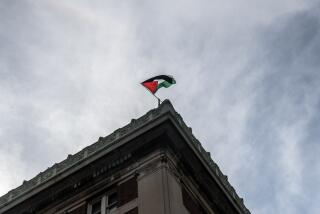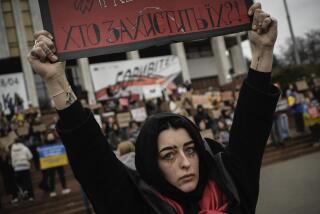Radiation Danger Was Worse Than Poland Admitted
- Share via
WARSAW — When radiation from the ruined reactor at Chernobyl swept across Poland last month, the Polish government quickly established itself as the most candid of Moscow’s allies in talking about history’s worst nuclear accident.
But it turns out that there were limits to Poland’s candor. Radiation figures the government supplied to the International Atomic Energy Agency in Vienna show that contamination from the Soviet reactor reached substantially higher levels than the Polish public was told.
Airborne radioactivity at one point exceeded 5,700 times normal levels, according to data the government gave the IAEA in early May. Fresh green vegetables showed high levels of radioactivity a full week before the government urged pregnant women, nursing mothers and children to avoid eating them.
Other Elements Not Reported
Moreover, while the government has published its measurements of short-lived radioactive iodine, which made up the bulk of the fallout, it has not told the Polish public about measurements of smaller but still significant amounts of radioactive cesium, tellurium, ruthenium and other more persistent isotopes.
The first such measurements were recorded April 28 and reported to the IAEA on May 5. But as late as May 18 the official press was still telling Poles that cesium and other long-lived contaminants “might start appearing in minimal amounts.”
(In a statement accompanying the data it submitted to the IAEA, the government said its measurements “indicate that there is no significant risk to health for any person in the country,” a conclusion the international agency has not disputed.)
The discrepancies between what the Polish people were told and the data supplied to the outside world through the IAEA constitute a textbook case of information management that, in a Western democracy, would have triggered a political furor.
Most Informative
Nevertheless, the Polish authorities did give the public much more information about fallout conditions within the country than other Soviet Bloc nations did in theirs.
Leading scientists appeared repeatedly on television with a welter of figures designed to reassure a frightened public that despite the nearness of the accident, radiation levels were well below the danger line. A special government commission issued daily bulletins that acknowledged contamination of air, soil, surface water, milk and--belatedly--fresh vegetables. The commission ordered the distribution of 10 million doses of protective iodine and restricted milk sales.
The Polish government followed this policy of relative candor even at the risk of angering Moscow, which confined its own information mainly to bland reassurances that everything was under control. Polish television can be seen by several million Soviet citizens in the western Ukraine, Byelorussia and Lithuania--the areas contaminated most heavily in the April 26 accident--and many people in these areas understand enough Polish to judge for themselves which government supplied better information.
Nevertheless, the Polish authorities appear to have withheld the most worrisome information from their own people. Western diplomats said the motive may have been to avert panic. But in doing so, they said, the government betrayed a striking lack of confidence in its ability to cope with truth in the face of a national emergency.
Heavy Exposure
Because of its proximity to Chernobyl, Poland appears to have received a heavier dusting of fallout than any country outside the Soviet Union itself.
At its highest levels, airborne radioactivity ranged from approximately normal to 571 becquerels per cubic meter on April 29 and 514 becquerels the following day in some parts of the country, according to figures the government gave the IAEA on May 5. A becquerel is a measure of radioactivity equal to the disintegration of one atom per second.
In its report to the IAEA, the government compared these figures to the normal level of 0.1 becquerel, indicating that peak airborne contamination in some areas of Poland exceeded 5,700 times normal readings. There was no indication of how large an area registered this high level of radiation.
The Polish public, however, was told on May 5 that the highest airborne contamination reached only 200 becquerels, less than half the maximum that a delegation of Polish scientists reported to the IAEA in Vienna on the same day.
No Background Given
Moreover, in giving the public the lower figure, the government compared it not to normal levels but to the much higher figure of 1,000 becquerels per cubic meter, which it said was the permissible limit under Polish health regulations. No information was published that would permit ordinary citizens to compare these figures to normal levels.
In what appears to have been a parallel effort at information management early in the crisis, some unidentified Polish scientists leaked figures to Western embassies and to some foreign reporters indicating that radiation levels were no more than 15 to 20 times normal.
In retrospect, these leaks appear to have been orchestrated by the authorities in the knowledge that they would show up in the Western press, be played back to Poland by the Voice of America, Radio Free Europe and other foreign stations to which millions of Poles stay glued in any crisis and ultimately reinforce the government’s credibility.
Later, at a news conference for Western journalists on May 1, members of the government commission monitoring the fallout said in response to repeated questions that the highest contamination observed in Poland was 500 times normal background readings at the small town of Mikolajki, 120 miles north of Warsaw.
Vegetable Warning
According to the IAEA data, however, much greater deviations from the norm had been measured in some samples of air, surface water and green vegetables, which ranged respectively up to 5,710, 596 and 621 times normal.
In addition, data given to the IAEA show that the government issued its warning against eating fresh green vegetables a full week after tests showed a dramatic increase in the radioactive contamination of vegetables.
Tests of green vegetables that began on April 30 showed a wide range of readings then and over the next three days, with the maximum peaking at 82,000 becquerels per kilogram on May 2. This corresponds to 2.2 million picocuries per kilogram, a unit used by the United States and some other Western countries. By comparison, the U.S. Food and Drug Administration sets its “level of concern” at 8,000 picocuries for food consumed by adults and 1,500 for children.
Didn’t Give Reading
It was only six days later, on May 8, that the government warned pregnant women, nursing mothers and children against eating leafy vegetables, but it never disclosed how contaminated they were. The government suspended the warning on May 14 and vegetable sales are returning to normal.
Ironically, the Polish authorities have cited the data they gave the IAEA as proof of their openness in dealing with the fallout crisis.
Under the one-word headline “Credibility,” the main government newspaper Rzeczpospolita on May 10 described the “exhaustive information on the situation in Poland” that a team of leading scientists had submitted to the international agency five days before but without mentioning the actual figures they presented.
More to Read
Sign up for Essential California
The most important California stories and recommendations in your inbox every morning.
You may occasionally receive promotional content from the Los Angeles Times.










